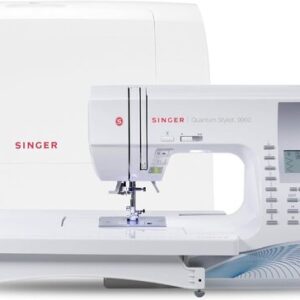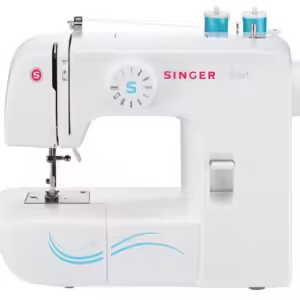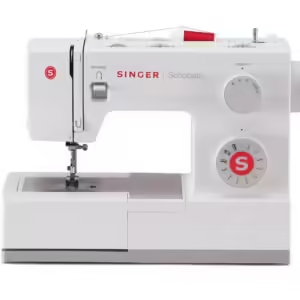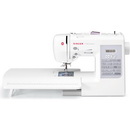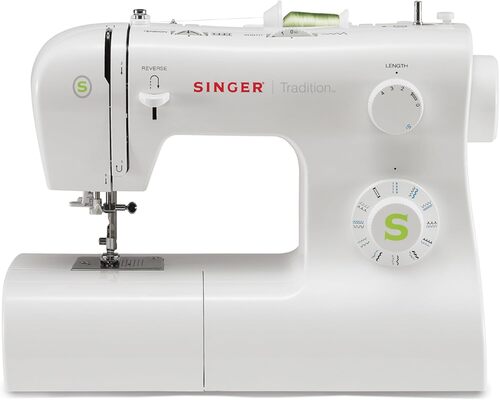
I still remember the spring afternoon I finally clicked “Buy Now” on the Singer Tradition 2277. I had spent days scrolling through Singer Tradition 2277 reviews — some glowing, a few grumbling — but a common thread ran through them: it’s a no-nonsense, beginner-friendly workhorse. That sounded like me — eager, thrifty, and totally rusty after a decade away from sewing.
First impressions
When the box landed on my porch I tore it open like a kid at Christmas. The machine was lighter than my old metal Kenmore, yet felt sturdier than the toy-like plastic models lining big-box shelves. Inside, I found extra needles, bobbins, feet, and a dust cover. No printed manual—just a tiny card pointing me to Singer’s website. No big deal; I fired up YouTube on my tablet and followed along.
Our rocky “getting-to-know-you” stage
My very first Singer Tradition 2277 review note would read: the automatic needle threader is magical… once you unlock its secret handshake. The trick, I learned, is to keep both the needle and presser foot at their highest positions. Miss that step and the threader sulks.
The bobbin gave me more attitude. Because the case loads vertically (not drop-in), I managed to install it backwards twice, causing the dreaded “bird’s-nest” of thread under the plate. One late night I finally slid open the little black latches, popped the bobbin assembly out, fished out an oily thread scrap, and — voilà — smooth sailing. Lesson learned: ninety seconds of cleaning saves ninety minutes of cursing.
First real project: quarantine masks
A week later COVID lockdown hit, and my “simple hemming machine” suddenly became a frontline hero. I cranked out 300 cotton masks for friends, neighbors, and a few grateful nurses. The 2277 handled two layers of quilting cotton plus ties without complaint. I kept stitch length at 2.5, tension around 4, and changed needles every 150 masks. The motor got warm but never wheezed.
Stretchy adventures and denim drama
Feeling brave, I tackled fleece pajamas for my nieces. Switching the dial to the S-1 stretch stitch and popping in a ball-point needle kept skipped stitches away. Fleece shed lint fast, so I brushed the feed dogs every evening.
Denim hems were tougher. The machine could chug over a four-layer flat-felled seam if I swapped to a size 16 denim needle, lengthened the stitch to 3, and slowed the foot pedal to a crawl. Anything bulkier made the needle protest or, once, snap. I now keep a hump-jumper handy to level thick seams.
Little quirks that still make me grin
- The side-mounted thread-cutter: I didn’t think I’d use it, but I swipe that blade dozens of times a session.
- Horizontal spool pin: No more runaway spools bouncing across the floor while winding bobbins.
- Speed pedal sensitivity: Whisper-light taps for precision, pedal-to-the-metal bursts for long curtains. Took practice, but now it feels like cruise control.
The not-so-perfect bits
- Thread nests: Operator error nine times out of ten, yet the machine is unforgiving if top threading misses even one guide.
- Dim work-light: I added an LED strip under my shelf — instant daylight.
- Plastic handwheel sheen: After two years it shows scuffs, though performance is unaffected.
- No drop-in bobbin: Vertical loading is fine once mastered, but beginners may wish for the transparent drop-in style.
Two years in: durability check
I sew three to five hours a week — placemats, dog-bed covers, cosplay tunics, and the occasional baby quilt. I oil the hook race monthly and change needles often. The 2277 has needed zero professional service. The reverse lever is a little stiff now, and loud fabric layers make the lightweight chassis shimmy, but stitches stay even.
Final thoughts—my personal Singer Tradition 2277 review
If you crave computerized bells, automatic tension, and embroidery alphabets, keep scrolling. But if you want a friendly, affordable companion that turns fabric and thread into wearable joy, the Singer Tradition 2277 punches above its price tag.
It taught my kids to sew pillowcases, powered through pandemic mask-making, and still helps me hem jeans on Sunday night when the workweek looms. Those are real-life victories you can’t measure in spec sheets.
After hundreds of hours together, I can honestly say: Singer Tradition 2277 reviews weren’t wrong — it’s simple, spirited, and stubbornly reliable, just like the best kind of friend at your sewing table.
Pros and Cons of the SINGER Tradition 2277 based on other Customer Reviews
| Pros | Cons |
|---|---|
| Beginner-friendly learning curve – numbered threading path, clear stitch dial and gentler motor help first-timers sew in under 30 minutes. | Vertical bobbin hassles – upright case confuses newcomers, winds unevenly, or “bird-nests” until users watch YouTube fixes. |
| Automatic needle-threader (when mastered) – once the trick is learned, it saves strained eyes; many reviewers call it their “game-changer.” | Threader hit-or-miss – a sizable minority say the auto threader never lines up or breaks, forcing manual threading. |
| Lightweight & portable – under 14 lb with built-in handle; easy to store, carry to classes, or pull out just for hemming. | Shakes at high speed – the same light plastic shell vibrates and “walks” across tables during fast stitching. |
| Solid stitch set for basics – 19 stitches (stretch, zig-zag, buttonhole) cover masks, curtains, crafts, even basic quilting. | Not a heavy-duty workhorse – bogs down on thick seams, leather, or multilayer denim unless you swap to heavy needles and go slow. |
| Value price – many buyers scored it under $100 and felt the quality still beat other budget machines. | Quality-control lottery – oily coatings, missing bobbin cases, faulty foot pedals, and dead lights appear in a noticeable slice of reviews. |
| Side thread-cutter & horizontal spool pin – small conveniences users end up loving for quick trims and tangle-free winding. | Foot pedal overly sensitive – a feather tap can send the feed dogs “rocket-fast,” making precise control tricky for beginners. |
| Low noise & decent speed range – quieter than older mechanical Singers; speed obeys pedal (once you learn its touch). | Dim workspace light – several sewists added an LED strip because the built-in bulb barely lights dark fabrics. |
| Good for masks, crafts & daily mending – dozens of owners stitched 200-plus COVID masks or constant household repairs without servicing. | Sparse or wrong-language manual – many U.S. buyers found only Spanish/French booklets; almost everyone ends up on YouTube for help. |
SINGER Tradition 2277 Sewing Machine – Frequently Asked Questions
How many stitches does the Singer Tradition 2277 include?
According to the factory manual, the Singer Tradition 2277 carries 23 built-in stitches—basic, stretch, decorative, plus a 4-step buttonhole—giving beginners and improvers plenty of choices without overwhelming them .
Is threading really easy on this model?
Yes. The front-loading bobbin follows a numbered track and the lever-style automatic needle-threader cuts eye-strain to seconds, a highlight in almost every Singer Tradition 2277 review.
What bobbin type does it use and how do I wind it?
Singer Tradition 2277 uses class 15 transparent bobbins. Pop an empty bobbin on the winder, snap the thread around the guide, push right, press the foot-pedal and the winder stops automatically when full—exactly as pictured in the manual’s winding diagram .
Can it handle jeans or thicker fabrics?
Yes—with the proper size 16 denim needle and a slower foot-pedal speed the internal metal frame and adjustable presser-foot pressure let the machine climb typical hem bundles, though it isn’t meant for heavy canvas all day.
What accessories come in the box?
The manual lists an all-purpose foot (already on the machine), zipper foot, buttonhole foot, button-sewing foot, pack of needles, three bobbins, darning plate, seam ripper/brush, L-screwdriver, spool pin felt, auxiliary spool pin and a soft cover .
How do I keep the Singer Tradition 2277 running smoothly?
Unplug, drop the bobbin case, brush out lint every few projects, and add one drop of sewing-machine oil to the hook race when it sounds dry; a simple maintenance chart in the manual shows the exact spot .
What warranty does Singer give on this machine?
The Singer Tradition 2277 carries Singer’s standard 25-year limited warranty on the internal metal frame, two years on electrics and motor, and 90 days on labor, giving peace of mind to new owners.
Is the Singer Tradition 2277 good for complete beginners?
Based on dozens of real-world Singer Tradition 2277 reviews —including the quick-start diagrams, DVD, and forgiving foot-pedal—most first-time sewists report they were stitching cushions or masks within an hour of unboxing.
| Feature | Specification |
|---|---|
| Model | Singer Tradition 2277 |
| Stitch Selection | 23 built-in stitch patterns (including straight, stretch, decorative and 4 auto-size buttonholes) |
| Stitch Width | Up to 6 mm |
| Stitch Length | 0 – 4.0 mm |
| Buttonhole Styles | 4 one-step, auto-size |
| Sewing Speed | Up to 750 stitches per minute |
| Motor | 100 W universal DC motor |
| Bobbin System | Front-loading, drop-in bobbin |
| Needle System | Uses standard Singer needles (needle plate marked “S” for reference) |
| Thread Cutter | Built-in manual thread cutter on left side |
| Presser Foot Settings | Adjustable presser-foot pressure for fine or heavy fabrics |
| Light | Built-in LED work light |
| Free Arm | Yes—removable flatbed converts to free arm for cuffs and sleeves |
| Accessories Included | 4 presser feet (all-purpose, zipper, buttonhole, button-sewing), bobbins, seam ripper, spool caps, screwdriver, lint brush, disc-style edge guide |
| Power Requirements | 120 V, 60 Hz (US); uses standard polarized plug |
| Dimensions (W × H × D) | 15.3 × 11.2 × 6.6 inches |
| Weight | 11.0 lbs |
| Warranty | 25-year limited warranty on frame; 2 years on motor/electronics; 1 year on labor |

